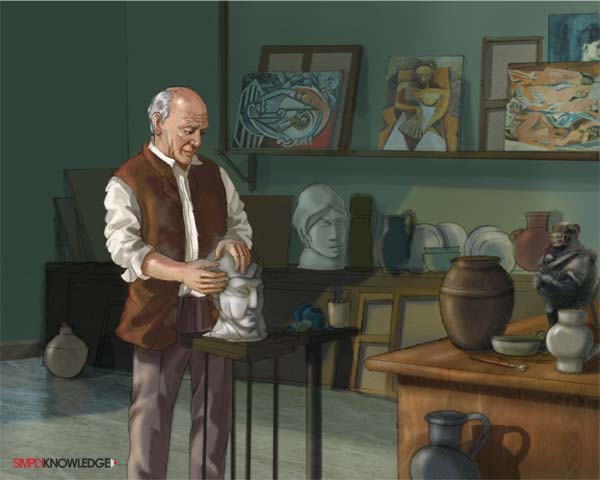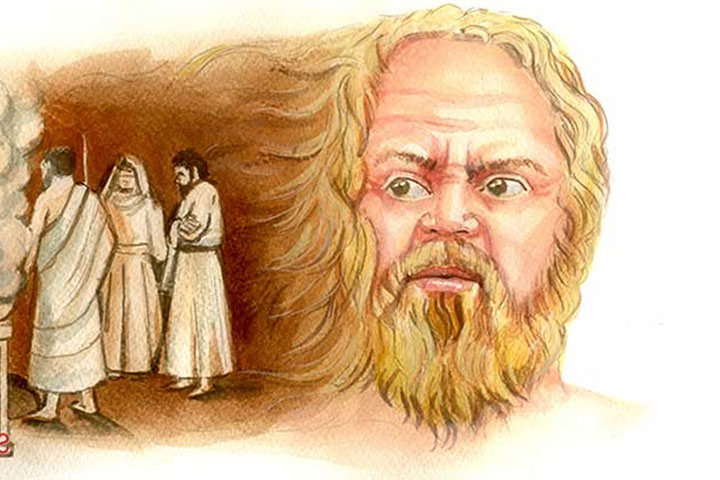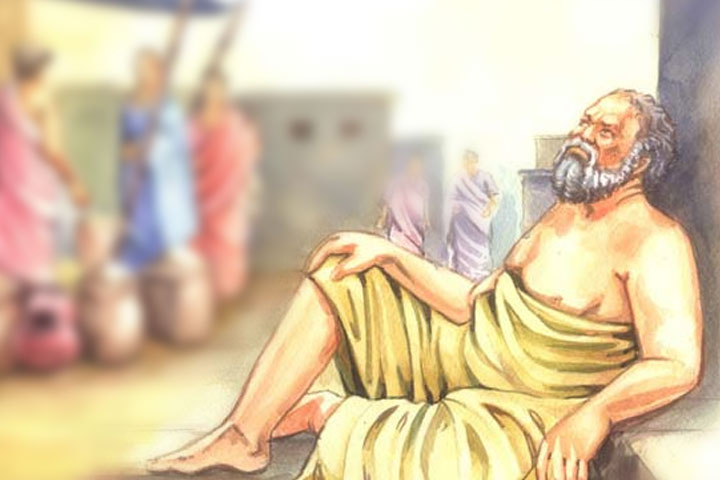
Pablo Picasso was a Spanish artist who is credited for his artistic genius in the field of Painting, Sculpting, Printing and Stage Designing. His work revolutionized the art world and laid the foundation of modern art. Abstract Art, Cubism and Collage Painting are also credited to his name. Creations of Picasso are still bought at exorbitant prices and treasured by many art lovers and collectors worldwide. In his long illustrious life, Picasso created around 50,000 pieces of artwork, comprising 1,885 paintings; 1,228 sculptures; 2,880 ceramics, roughly 12,000 drawings, many thousands of prints and numerous tapestries and rugs. His many paintings portrayed his alter ego – Minotaur (a Greek mythical monster with the head of a bull and the body of a man).

Many modern day artists take inspiration from his work but only a fraction of them have achieved success like Picasso. Picasso’s work was influenced by personal trauma, tragedy and joy. This is a story of a liberated soul, who painted his own life on canvas.
In his own words:
“Art is not the application of a canon of beauty but what the instinct and the brain can conceive beyond any canon. When we love a woman we don't start measuring her limbs. Art is a lie that makes us realize truth. There is no abstract art. You must always start with something. Afterward you can remove all traces of reality. ”

The Inception
It was a usual day of 25th October, 1881, in a small city of Malaga, a southern laid back province of Spain. On the very day an ordinary middle class family was blessed with a baby boy. The proud father Don José Ruiz y Blasco, a local painter, and mother María Picasso y López, baptized their first child as Pablo Diego José Francisco de Paula Juan Nepomuceno María de Los Remedios Cipriano de la Santísima Trinidad Ruiz y Picasso. Back in those days, it was customary in Spain to incorporate the names of the native, family members and saints during the christening of the first child. Rural and rustic Malaga in the late 19th century was a small city with overcrowded markets, with buzz for weekend bullfights and empty magnificent beaches. The nostalgic city was the least developed European town of its era and far away from the industrial revolution. In this rustic city of Malaga began the journey of Picasso, the rock star of the art world who lived a bohemian life and created one masterpiece after another. Picasso’s life, like his paintings was full of colours, sometimes cheerful, sometimes grim and sad. He drew inspiration from the people, surroundings and emotional situations. Breaking the old barriers and unfazed with criticism, Picasso was widely known for co-founding Cubism Art, Collage Painting and Modern Sculpting. Picasso’s art had a tendency to shock, awe and captivate the audience at the same time. Indeed, he was a genius and showed signs even before he could speak or walk. A prodigy to be precise!
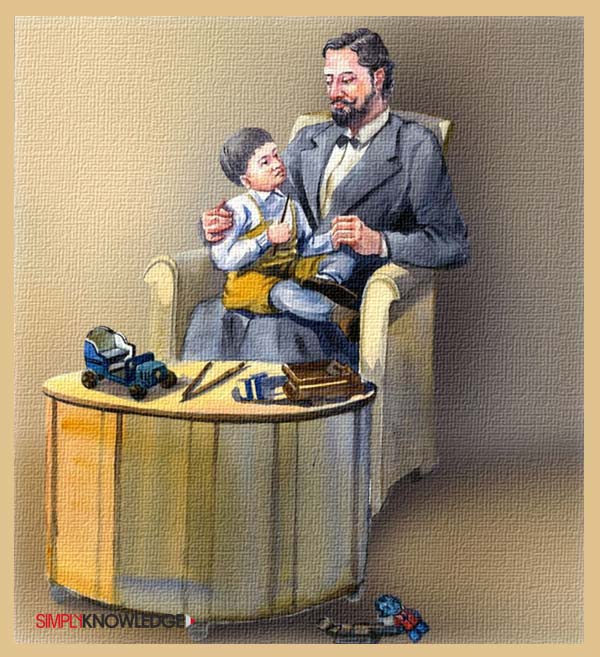
As a toddler, Picasso’s first words were “Piz-Piz” (“Lapiz” – meaning Pencil in Spanish). The artist father recognized the infant’s fascination with art and encouraged his son further for drawing and painting. Don Jose as a painter received very meager remuneration for his artistry and his major source of income came from an art school, where he tutored young artists. In order to meet the needs of his family, he also worked as a curator at a local art museum. The doting father once took his three year old son Picasso to a bull fight; the sight of Matador’s machismo and the magnificent bull’s fight for survival seeded a germ of art in Picasso. The bull fight left a great impact on Picasso’s young creative mind; the romance with death fascinated him. At the age of eight, Picasso drew his first clumsy pencil drawing of the ‘Bull – fight’. His nestling brain captured the entire event and transmuted it on a paper in the form of rough pencil strokes.

Being the only son and the first child in the family, Picasso was adored by everyone at home. He was the center of attention and was always surrounded by female members i.e. mother, two aunts, two younger sisters Lola and Conchita, and a maid. The man of the house, Jose was a self centered artist who spent most of his barren time with close friends at local cafes or at the museum. He was famous for visiting brothels, where he drew inspiration from Cyprians nudity. As a painter, Jose was an average, his skill and imagination was bounded and he mostly drew paintings of pigeons and local surroundings and there were not many buyers for his lack luster artwork.
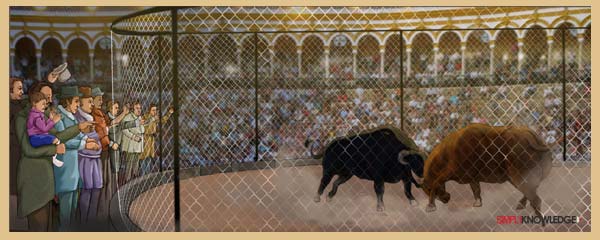
During the absence of her husband, Maria devoted her entire love for Picasso. She adored her son and often praised “If you are soldier, you will become a general.....if you are a priest, you will become a pope.” Years later Picasso proudly added, “I was a painter and became Picasso”.
As a young boy, Picasso showed enthusiastic interest in drawing and often imitated his father by holding a brush in his hand. Seeing Picasso’s eagerness, Jose once asked his ten year old prodigy to paint the feet of pigeons in one of his unfinished paintings. Picasso happily embraced the opportunity with both hands; he could not have asked for more. For reference, Jose nailed a pigeon foot onto the canvas board and left for the museum. Hours later when Jose arrived, he was impressed on seeing a very realistic pigeon feet on the canvas; very proudly he called for his son and said “you are great painter then I am, here, take my brush and colours, I no longer need them”
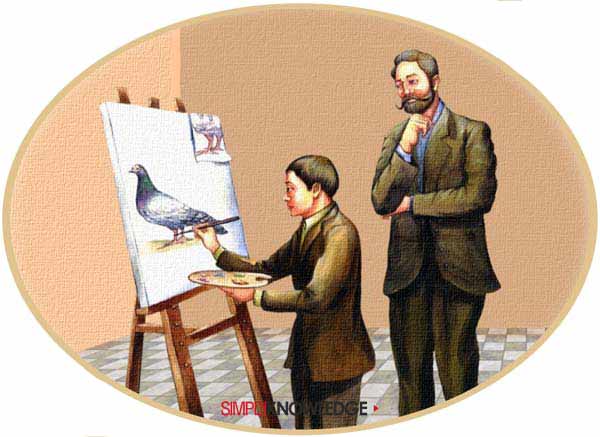
Picasso had natural keen eyes; his gaze often charmed, intrigued and had a strong intensity. He would often joke “I can directly look at the sun”. It was quite evident that Picasso was obsessed with art. At school, during Arithmetic lessons he often drifted away doodling or sometimes turning numbers into different shapes of the nose. He would draw cartoons of people he came across every day; even the vowels seemed to him like human figures and he drew them in various positions. His hunger for art was well noted by Jose and he personally took up the initiative to pedagogy his son about the paintings. Picasso was an obedient pupil and absorbed his father’s lessons quickly. Over the years, the father son bonded strongly with the cement of art. Picasso in his later years always acknowledged his father for teaching him the basic fundamentals of painting. With age, Picasso’s skills grew rapidly and by 13, he painted portraits of his mother, aunt, father and his sisters with precision. Jose was proud of his son’s splendid skills and knew that he would make something good of his talent someday. However, Jose’s own future as an artist seemed blurry.
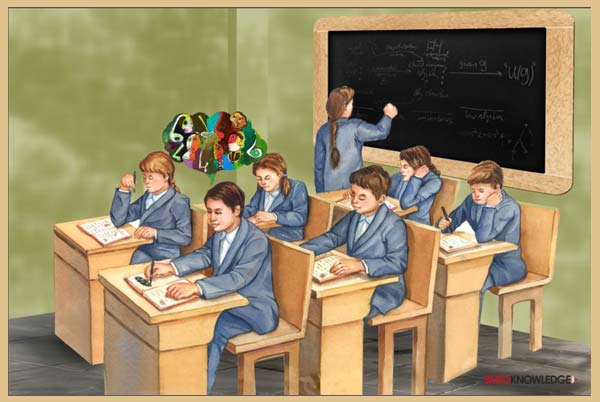
In 1894, now in his teens, Picasso came across Anheraz Mandez- a pauper girl and first crush of Picasso. Madly in love, he drew her paintings, and often made her sketches in his book, depicting Anheraz as an angel, surrounded by Cupids. Some say that this was the awakening of his erotic side.
The joyful colours in Picasso’s life faded when Jose lost his job at the museum in June 1895. Left with no choice, Jose along with his family moved to the cold Northwest city of Caronia, in search of livelihood, leaving behind the sunny Malaga. With his passable experience of tutoring, Jose found a job at the local art school. The money was short but enough to meet his family’s needs. During their stay here, Picasso’s younger sister Conchita got severely ill with diphtheria which was quite widespread in Europe at that time. Picasso was very close to his younger sister and got deeply affected by the incident. He prayed to God that if Conchita survived, he would never paint again – an earnest and massive sacrifice which a 13 year old boy was ready to induce for his sibling. All this while, the family was waiting for a serum from Paris to cure the illness. Unfortunately, Picasso did paint and Conchita died as the medicine could not arrive early. Picasso was devastated and he felt that God had punished him for his mistake; he believed, his painting had caused Conchita’s death. The setback penetrated deep inside his heart and soul and resurrected in his later paintings.
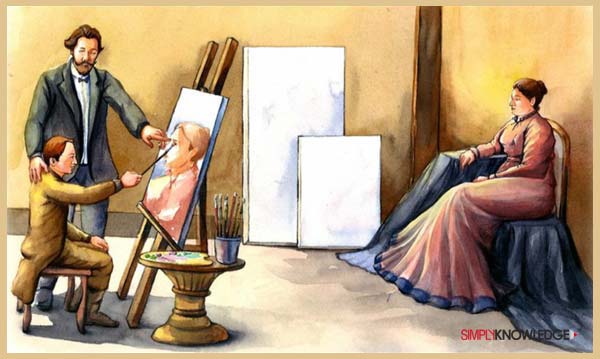
The girl was buried at the local cemetery, but Jose could not afford the headstone for her grave. The sorrow incident made Picasso superstitious and he kept on adding irrational rituals every year in his life. One such superstition he followed was to sit on the steps of his house for a minute before going out; he even made this compulsory for his kids later.
Soon after the tragedy, Jose no longer wished to stay in Caronia and the family moved to Barcelona, a cosmopolitan city on the verge of the industrial revolution. Barcelona was way modern and commercial as compared to Malaga. Jose took up a high salaried job of professor at an illustrious art academy of the city. While adjusting in the city, Picasso gave an entrance exam for the very same academy where Jose worked as a Professor. After careful assessment of his work by the administration, Picasso was enrolled in a higher class of seniors. At the academy, he was trained among the older, experienced students with far more sophisticated skills. Seeing the young Picasso’s work, many senior students appreciated his talent and invited him to cafes and private soirees. Picasso was happy with his new life, friends and the city, but soon violence and riots erupted in Barcelona and clashes between the labours and lawmakers intensified. Gleaning inspiration from the distressing surroundings, Picasso painted pictures of riots and violence. Some express their emotions verbally, some in the form of anger, some show it on their face or via body language, but Picasso chose art as a medium of expression.
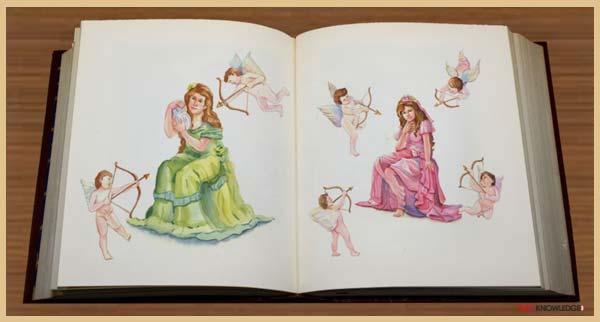
During the times of social and economic unrest, many senior friends of Picasso turned anarchist and conceived radical plans to topple the government. This shocked the young artist and he maintained a distance from the radicals henceforth. Eventually, the riots subdued by negotiating terms peacefully, and harmony once again set in.
Back in those days, it was a common joke in Spain that “Spanish Men spend Sunday morning at Church..... afternoon at the Bull Fight and evening at the brothel”. The joke turned out to be true for Picasso. His friends introduced him to the red light areas of Barcelona. Visiting these brothels awakened Picasso’s interest in sexuality and women’s anatomy, and it reflected prominently in his art throughout his life. In his teens, Picasso was a regular at the brothels and proved true to the old saying “like father... Like son”. Picasso was known to visit brothels just like his father, only his art was far superior than his mentor’s. During these sinful visits, the Minotaur was unleashed inside Picasso, which left its impression on canvas.
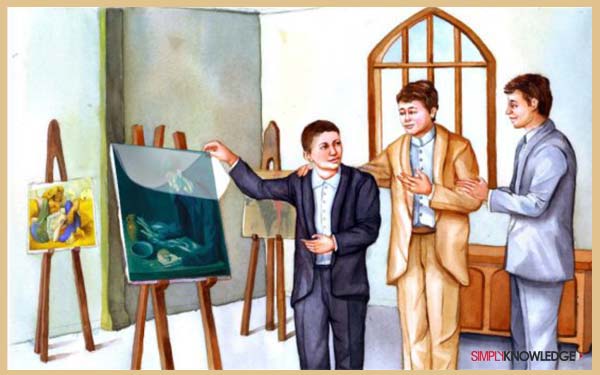
Under his father's shadow, Picasso was much more sober and obedient. Jose knew the spurts of adulthood would distract his son from attaining glory and therefore, he guided Picasso by carefully engaging him in productive ventures. At the age of 15, Picasso made ‘Science and the Charity’ depicting a doctor nursing a sick woman and a nanny by her side carrying women’s baby. It was a remarkable painting and the concept was a tribute to his uncle Salvador who was a well known doctor of the town and often supported Jose and his family financially. Though Picasso could not stand his uncle he still drew and painted realistically, capturing every minute detail and expressions of the models and their surroundings. ‘Science and the Charity’ is still considered as one the best works of Picasso. That year, the painting won a Gold Medal at Malaga Art Exhibition and Jose was convinced that his son would one day become a great artist.
Interesting Fact: The person in the painting posing as a doctor was Jose himself, the sick woman was a poor gypsy and the nun was actually a boy posing as a woman in nun’s costume.
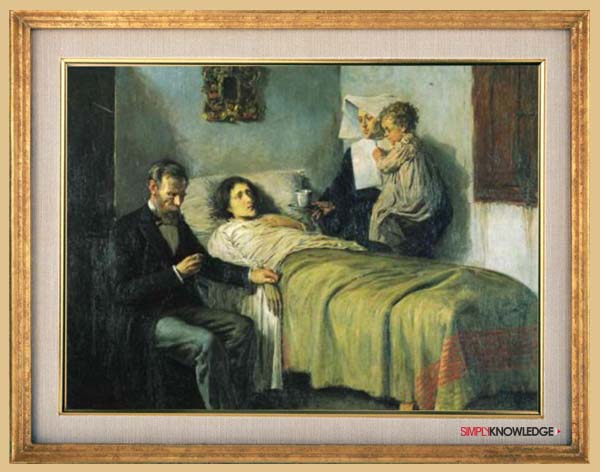
After the success of ‘Science and Charity’, Jose realized that religious paintings were more saleable than abstract art. He encouraged his son to paint religious paintings, and following his mentor’s instruction, Picasso drew a portrait of his father and sister Lola attending a communion. To symbolize the death of Conchita, he drew one unlit candle along with two burning candles depicting Lola and Picasso, the surviving children. A sheer genius he was. Picasso was apparently good at classical painting and was fascinated with paintings of legendary Spanish painter Francisco Goya. The paintings, ‘The Disaster of War’ and ‘The Art of Bull Fighting’ became Picasso’s main source of inspiration.
The prodigy since childhood was competitive and detested traditional art form and wanted to create one of his own. He was bored with the monotonous exercises at the academy. In 1887, Picasso’s family sent him to the capital of Spain, Madrid, where he was enrolled in Art Academy of Madrid to further hone his talent. One day, bugged with repetitive art exercises and traditional art form methods, Picasso wrote to his friend living in Barcelona “Nobody else has done as shocking as my drawing is going to be.” Picasso was secretly developing and laying the foundation of the Modern Art.
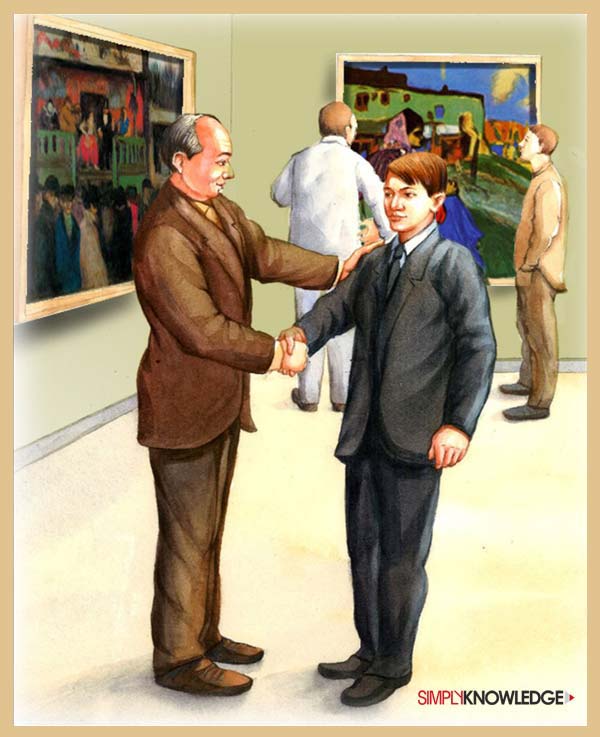
In 1898, Picasso dropped out of the academy, much to his father’s dismay. He later told his friend “in art one has to kill his art.” Picasso returned to Barcelona and worked independently for some magazines as a cover illustrator. To pay his rent, Picasso also made commercial drawings and posters for carnivals. For the next one year, Picasso not only did commercial paintings but also drew self portraits along with pictures of his friends and occasionally some random creative concepts. His personal artwork was exhibited locally. Though a good platform to showcase his talent, there were only a handful of patrons who appreciated his talent and criticism also came around. Some critics went further stating, Picasso’s style was ‘Uneven and Sloppy’. Unfazed with criticism, Picasso basked in the glory of his modest achievement. In this very first public exhibition, Picasso did not sell much, but not all hope was lost and one of the exhibitors promised him a show in Paris. Excited with the prospects of a new audience, Picasso left for Paris in 1900 along with his close friend Carlos Casajamos, a wealthy aspiring poet and a confident Spaniard, who was addicted to alcohol and drug abuse.
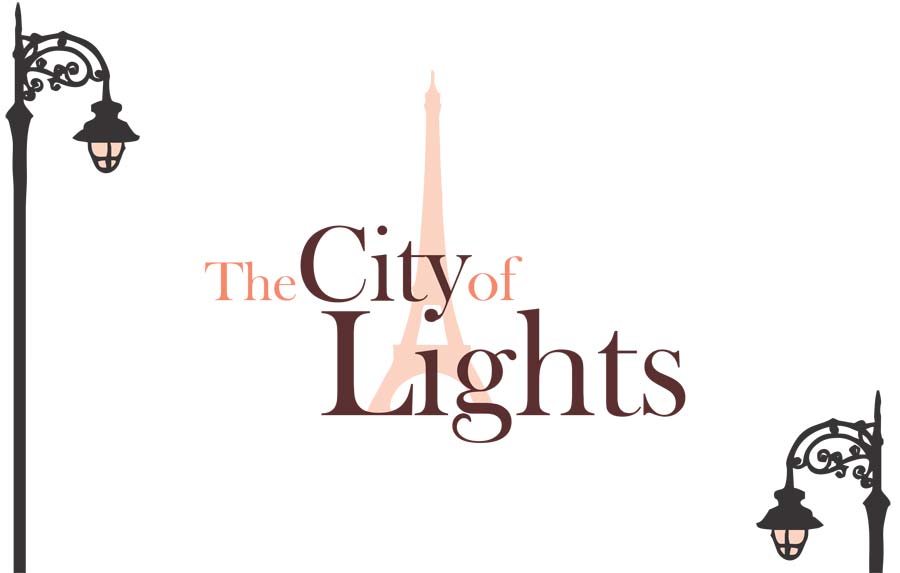
The City Of Lights
Paris amazed the young Picasso. The City of Lights was one of the most modern cities in Europe, a Mecca of the art world, where people from all around the world came to see the man made structure ‘Eiffel Tower’, the enchanting ‘Monalisa’ and the aphrodisiacal ‘Moulin Rouge’. Paris had already leapt far into the new century; the modern lifestyle and openness mesmerized the young Picasso and his friend Carlos. The Spaniards took up a small room in a not so fancy area of Paris. They holed up during the day and spent their nights at cafes and Moulin Rouge. Struck with the lustiness of Paris, Picasso created a series of paintings showcasing ‘Couples in erotic positions’, ‘Moulin Rouge’ and ‘Paris glamorous nightlife’. Both Picasso and his friend spoke poor French and they spent most of their time together with other Spaniards in the city. In his group, Picasso was often mocked for his southern Spanish accent and mannerism, as back then, people from the north usually considered southern Spain as a less sophisticated and down rated place. Picasso detested being mocked; he believed he was far superior to anyone around and knew that he was talented and a born genius. One should note that at such a young age, where Picasso was yet to make a mark in the art world, he was brewing with confidence; he was a Matador, a fighter and it often reflected in his words and in his art.
During their stay in Paris, Picasso and Carlos got acquainted with a group of young French models of which one of the models named ‘Jerne’ hooked up with Carlos. Though Picasso had lost his heart to this pretty woman, he could not confess to his dear friend Carlos who was smitten by Jerne’s beauty. Picasso dated another model friend of Jerne for a brief period. On Picasso’s 19th birthday, the couples went to celebrate at the art gallery, where Picasso’s paintings were put up for the exhibition. But Picasso was disheartened with the cold response he received from the visitors. His art did not captivate the imagination of French patrons. Dejected, Picasso set out to see the work of the other painters. Seeing the French artist’s tasteful use of colours and composition, Picasso was amazed and he incorporated French visual style in his work and created versions of existing famous paintings by notable artists. Soon, Picasso’s new collection got a buyer, and he got handsomely paid for his paintings. With his pockets filled, Picasso and Carlos returned to Spain. Soon after their arrival, Carlos started missing his love Jerne and he went back to propose her for marriage. However, she rejected on the grounds of his incompetency in bed. A dejected and angry Carlos pulled out a gun in the company of his friends at a local cafe and fired at Jerne but he missed. He then put a gun to his head, pulled the trigger and killed himself.
In Madrid learning about his friend's death, Picasso was devastated. He believed he could have stopped this incident had he been along his friend’s side. Picasso was sunk deep in remorse, which ended soon when one of the art exhibitor ‘Ambrose Vollard’ from Paris, invited him to showcase his work exclusively at Vollard’s gallery. Encouraged with the invitation, Picasso returned to Paris with a new zeal and stayed at the flat of his late friend Carlos, where the rent was already paid. Picasso worked tremendously for the next one month and after working day and night, he created a new collection for the show. The exhibition was a grand success and unlike before, many of his paintings were sold. Critics this time praised Picasso for his creativity, choice of colour, themes and composition. One critic went further, describing his art as ‘Spanish Invasion’. It boosted Picasso’s confidence and for the very first time he signed his painting as ‘Picasso’ instead of ‘Pablo Ruiz Picasso’. A self portrait of Picasso hung in the exhibition was titled ‘Yo Picasso – I am Picasso’. He boasted his arrival in the art world of Paris. A few days after the success of his exhibition, Picasso met Jerne and within weeks, started an affair with the girl who had broken his friend’s heart and eventually led him to suicide. Picasso not only lived in his dead friend's apartment but also bedded his beloved Jerne. This often gave him nightmares and a guilt laden Picasso was constantly haunted by Carlos memories. This remorse now reflected in his art.
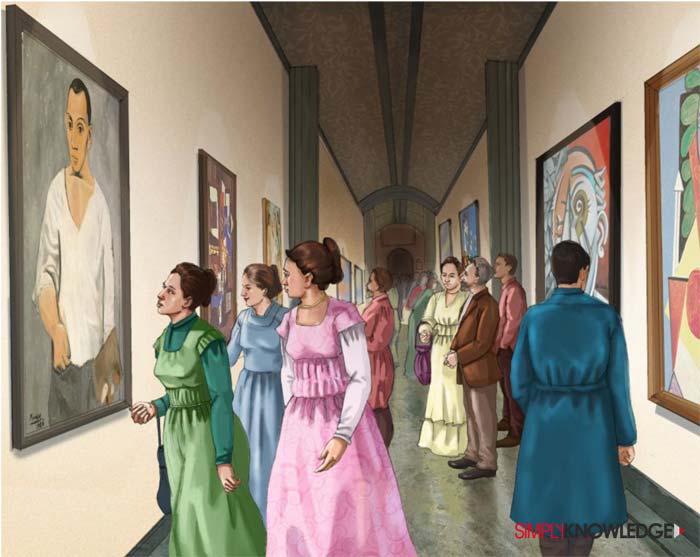
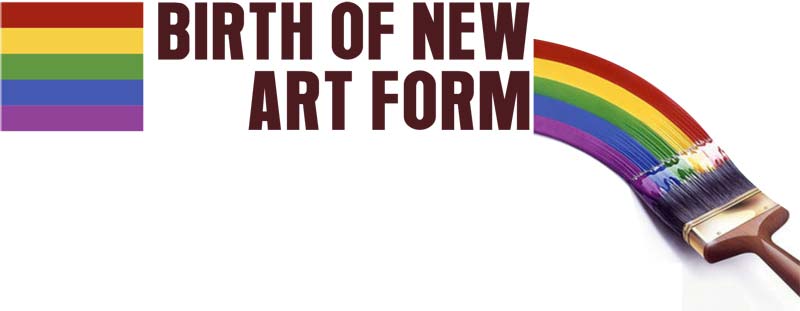
Birth of a new art form
A remorseful Picasso now started painting in blue colour and in one such painting he drew his dead friend Carlos, with a bullet hole in the head and a burning candle besides the bed lighting up his calm, dead face. Picasso made many paintings in tribute to his friend and this led to the famous ‘Blue Period’. The tragedy of death, loneliness, hunger and poverty reflected in his ‘Blue Period’ paintings. For the next one year, Picasso created only blue coloured portraits. The artwork, colours and concepts were too sad and grim for the buyers and they disdained his work completely. The critics who had shown their appreciation earlier now unleashed hard criticism. One of the critics accused Picasso, saying he drew blue paintings because “he brought plenty of blue paint at a reasonable rate”. In these testing times, Picasso made a self portrait - he looked sad, hungry and broke. With no money left, Picasso returned to Barcelona in 1904. A few months later, undeterred, he once again made up his mind to return back to the art capital of Europe, Paris!
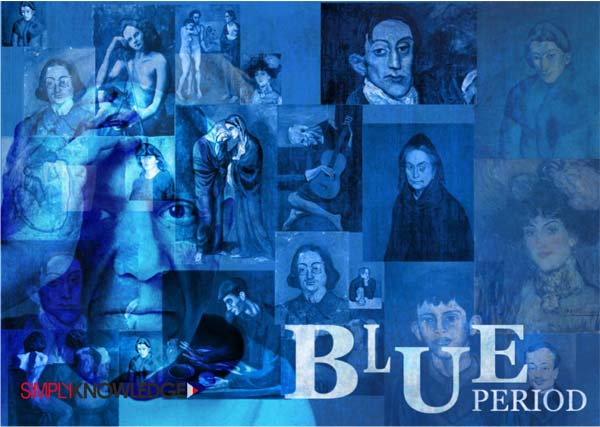
At the age of 24, Picasso was certain that his situation was temporary. His confidence was high as he had already marked his place in the art world. He bounced back like a true Matador, who after getting injured, rises and slays the beast. Picasso came back to Paris; head held high and rented a small place which he shared with other tenants, who mostly worked as play writers and poets. The roommates flocked to work during the day while Picasso slept, as he worked at nights. The condition of Picasso remained unchanged for some time but things turned ugly when winters approached. To keep their shelter warm, Picasso had to sometimes even burn his own paintings.
With over four years in Paris now, Picasso’s future still looked fuzzy. On top of that, his French was still very poor and he was mocked for his accent and dusky complexion by the locals. Standing 5”3”, Picasso’s short stature never became a hindrance; he was by far charming, tasteful and a strongly built person. He sported neatly parted, well oiled hairstyle matching his tasteful clothes when socializing. Growing up with the females in his childhood gave Picasso immense confidence to approach women without hesitation.
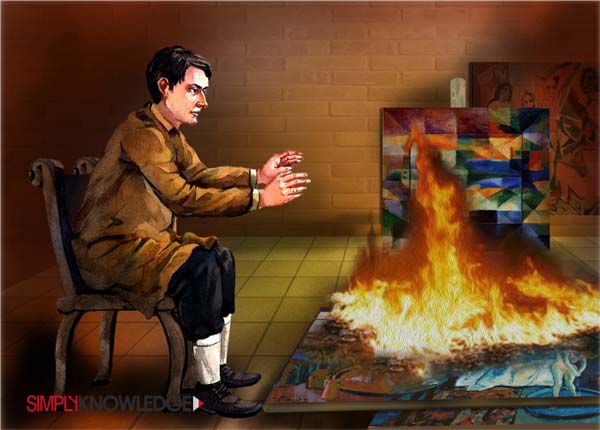
Once while taking a stroll, Picasso came across a young beautiful woman, Fernande Oliver, a painter’s model by profession. Picasso charmingly approached her and invited her to his studio, and very soon their love blossomed during the painting sessions. Oliver became Picasso’s new muse and he dedicated many paintings to her. Picasso was madly in love but he was also a jealous and a possessive boyfriend. He distrusted Oliver and locked her inside the apartment. Sometimes, he even stole her shoes so that she could not go out. Oliver was frightened with her lover’s erratic behaviour, but she always described Picasso as a passionate, loving and caring person. It was two years since his arrival in Paris and Picasso now started feeling home sick.
In 1906, Picasso and Oliver went to Spain on a vacation, which Oliver later described as their honeymoon. Close to nature, Picasso felt alive and filled with new energy and a beautiful woman in his life, the artist made paintings inspired by the local beauty, colour of the soil and ‘au naturel’ beauty of Oliver. A few months later, when Picasso and Oliver returned to Paris, they were welcomed by summer heat, bed bugs and a rat infested home. Some of Picasso’s paintings were also damaged by the rats. To make the matter worse, arguments often broke between Picasso and Oliver and they soon left the dreaded place.
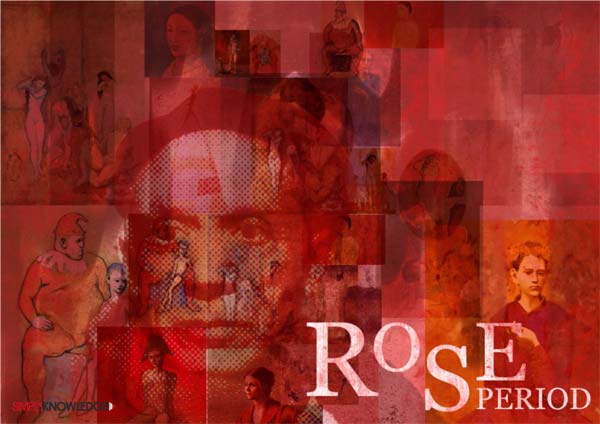
Once Picasso’s close friend introduced him to a circus troupe. Mesmerized with their life, Picasso drew inspiration and created many paintings, this time using more of red and pink colours. The colours of passion, love and lust! These series of paintings were later known as ‘Rose Period’. The new collection of paintings drew the attention of art collectors and soon many of his paintings were sold. During the Rose Period, even the demand for “Blue Period” paintings from the past grew rapidly. Money now started coming from all ends; Picasso had finally tasted success. He moved into a spacious house and spent lavishly but soon the party got spoilt, when another radical painter Henri Matisse came into limelight.
A lawyer by profession, Matisse gave up his practice for the sake of art. His style and skill was unique, he too squashed traditional norms and created jaw dropping modern art paintings full of joy, romance, nature and sexuality. Soon after learning about Matisse talents, Picasso’s competitive spirit kicked in and he secretly visited the Matisse Gallery and was rather impressed with his work. Picasso envied Matisse and they both met on a number of occasions. Matisse was a social magnet, a sophisticated gentleman, who could speak for hours like an intellectual on any given subject. On the other hand, Picasso with his limited schooling and bohemian lifestyle was blessed with skills and vision like no one else. Over the next few decades, their healthy rivalry became sort of a legend.
In search of inspiration, Picasso once came across an ancient Spanish stone art, a statue from 3rd-4th century BC. Picasso was mesmerized by its beauty and he desired to own them. One day, Picasso’s friend stole the Stone Age head from the museum and the following day he again went to the museum and stole another statue. Both the stones were later sold to Picasso for 35 francs. Picasso incorporated the Stone Age designs in his paintings, giving tribute to the ancient Spanish cultural.
In 1907, a 26 year old Picasso was introduced to African art. The traditional war masks and idols changed his philosophy of art forever and he told his friends “now I know the real reason why I become a painter”. He believed that his art was meant to connect with the spirits; the canvas was a medium where two worlds met. Picasso’s style was about to change dramatically and he bought himself a few African masks and believed that they gave him magical powers and protected him from the evil women’s spirit.
With the passage of time, Picasso’s relation with Oliver turned sour. She kept herself locked in her room, while Picasso, standing stark naked, drew paintings of nude women in their living room for hours. Picasso’s new creation laid the foundation of Modern Art and he titled it ‘Women of Avignon’. The concept was based on his teen year’s experience of visiting the brothels. With ‘Women of Avignon’ Picasso did not only break traditional norms, but created new ones as well. The circular shapes were now replaced with cubical forms, the realistic approach of detailing was squashed by clumsy brush strokes and disfigured shapes, and women in the picture nowhere resembled the models. Highly impressed with African art, Picasso made the face of two women bearing scary African masks. According to Picasso, they were a reflection of Oliver. On completion, Picasso invited his friends home to showcase his new art. However, instead of appreciating his painting they were horrified looking at it and could not understand the artistic message it conveyed. Picasso had created something which belonged in the future. He was highly criticized for his work. One critic said “one day Picasso will hang himself behind the painting”. Picasso was obsessed with African art and he said, “Negros used their art as a weapon, it can kill, it can exercise.”
The “Women of Avignon” gave a glimpse of Picasso’s new creation ‘Cubism’. Oliver never understood the concept and the idea of being painted in the form of ugly geometric shapes turned her off. The friction between the couple slowly turned surly. Picasso now paid less attention to Oliver and to teach him a lesson, Oliver started an affair with a fellow local artist. She was dying to seek Picasso’s affection but it was a vain attempt. To keep an eye on Picasso, Oliver asked her close friend Eva to spy on him, but enchanted by the artist, Eva double crossed Oliver and started an affair with Picasso. Eva took great care of Picasso and he too loved her equally. Eva was now his new muse!
Obsessed with the new art form, Picasso further developed it with a renowned artist of Paris, George Braque. Together, they changed perspective principle of paintings and even introduced text and newspaper articles in their creation. The duo’s new language of painting was termed ‘Collage’ and ‘Cubism’. From 1907 to 1914, their style flourished and they created many artistic creations together. Picasso dedicated his new art form to Eva and occasionally mentioned her name in his paintings.
In 1913, Picasso received unpleasant news of Jose being on his death bed and calling for his son. Picasso rushed to his father's side immediately. The dying father was unhappy that his gifted son had embraced ‘cubism’ and ‘collage’ and disdained the traditional classical European painting style. Jose wanted his son to become a classical painter and shun his modern art form, but Picasso was adamant! Battling old age, Jose died shortly after Picasso’s visit. A devastated Picasso came back to Paris where he continued his work in cubism.
Picasso received another blow in 1914, when Germany declared war on France. It changed everything in Picasso’s life and art. Braque, Picasso closest ally, volunteered in the war and went away to fight the Germans. Many of Picasso’s male companions during the time of World War I enrolled themselves in the army. Being a foreigner, Picasso felt that this was not his war and hence he should not take any sides. However, he was criticized for such views. Back then, women used to hand away white feathers to men who did not volunteer for the war. Picasso was the recipient of ‘white feathers’ on a number of occasions. Angered and frustrated, he relived his emotions on canvas.
In 1915, Eva fell sick and was diagnosed with Breast Cancer. She, however, told everyone that she was suffering from Tuberculosis. Picasso paid her a visit every day and drew a portrait showing her pain in the form of ‘pointed and nailed bosoms’. Within a few months, Eva passed away battling cancer. Picasso was now left all alone; he perceived, his life was falling apart. In his downright loneliness, he befriended a young girl Marice Gaby. She was bright and beautiful and soon became Picasso’s new source of inspiration. Picasso reintroduced colourful organic style of painting, as he was madly in love with Gaby. To win her affection, Picasso wrote several love letters to her and at the end of every letter he signed his name intertwined with hers. After dating for some time, a lonely Picasso proposed Gaby, who turned it down in a respectful manner, for reasons best known to her. Once again dejected, lonely and heartbroken Picasso now resorted to secluded life. His interest in the art diminished with each passing lonesome day. A much needed inspiration and joy is what he constantly searched for.
Life once again smiled at Picasso in 1917, when he met a renowned poet Jean Cocteau, who introduced him to the world of Ballet. The sophisticated, upper class lifestyle was very different from what Picasso was living by far. Picasso started designing stage sets for the ballet company. In the ballet troupe of young girls, Picasso was attracted to a young Russian ballerina Olga Kakalowa. They spent hours together in each other’s company and several dates later, Picasso proposed Olga for marriage which she happily accepted. In 1919, Picasso and Olga took their vows at a Russian Church. Soon after the marriage, Picasso’s life changed dramatically. At Olga’s instance, he now attended Operas, fancy dress parties and Cocktails like a gentleman clad in a suit. Picasso liked the attention at the social gatherings, but could not stand the glitter and glamour which came along with it. In the crowd he was always lonely and his inner Minotaur wanted to set free. Like always, Picasso found solace in his art; Olga was his new inspiration. With every new girl in his life, Picasso strikingly changed his painting style and this time he embraced the neoclassical style. The limbs of the model were painted large, giving it a godlike look. With Olga, happiness had returned in Picasso’s life and he created one masterpiece after another, reflecting the joy of life. He also made several paintings of Olga.
In 1921, Olga gave birth to a baby boy. The delighted parents named him Paulo. Picasso was a proud and caring father and spent hours playing with the kid or painting mother and child themes. To reconnect with nature, Picasso along with Olga and Paulo went to French Riviera. Part reason for this shift was the glittery lifestyle of metropolitan Paris. The bohemian artist craved for nature and wanted to work in peace. However, Olga was raised and fed on limelight since childhood and therefore she constantly argued with Picasso for his reserved nature.
At his new residence in French Riviera, Picasso befriended a group of intellects, who called themselves ‘Surrealists’ as their philosophy was based on Surrealism (A 20th century movement of artists and writers developing out of Dadaism who used fantastic images and incongruous juxtapositions in order to represent unconscious thoughts and dreams. )The Surrealists taught Picasso to imagine objects, people and places in a surreal manner. Surrealism blew away Picasso’s mind and he was now charged with a new form of energy, passion and genius. He created jaw dropping visuals, compositions and perspectives which were never seen before. So engrossed was Picasso in his art that he failed to see that his relationship with Olga had entered murky waters. The small disagreements led to arguments and arguments led to fights, and with time, their petty conflicts intensified. Picasso, who until now was making beautiful pictures of Olga, vented his anger by painting ugly portraits of her. This added fuel to the fire and love now seemed to be completely lost between them. By 1927, Picasso lost his interest in Olga and he now set his eyes on Marie Therese, a girl he saw in a departmental store. Once when Picasso invited the blonde to his studio, he said “I am Picasso... you and I are going to do great things together.”
Picasso was aware that Marie was a minor (she was only 17) and any sexual advance towards her would lead to cancelation of his visa. Therefore, he convinced his new muse to keep their affair a secret. Under the spell of the artist, Marie often lied to her mother and spent every afternoon in Picasso’s studio. Maddened with lust, Picasso created a series of erotic portraits of Marie sleeping or pleasuring herself. The famous painting ‘The Dream’ was inspired by Marie. In several paintings, Picasso portrayed himself as a Minotaur ravaging and deflowering the young beauty. The Minotaur was Picasso’s alter ego. He considered himself a monster who was not only a crusader but also a cursed victim at the hands of almighty. Picasso’s famous painting ‘Minotauromachy’ showed a Minotaur, a dead horse, a virgin female Matador and a young torch bearer. This manic portrayal of himself was justified years later by Jacqueline Roque (Picasso’s second wife) as a grief of his sister’s Conchita’s death. Picasso’s Minotaur depicted sacrifice for the great art.
Marie was often invited as a model to Picasso’s house in presence of Olga. The latter never suspected her husband’s debauchery, till one fine day in 1935 all hell broke loose when Olga discovered that Marie was pregnant. She stormed out of the house with Paulo and sheltered in a hotel and the couple got separated forever. However, Picasso never gave divorce to Olga, as he did not want to give away his wealth according to the French Law. Olga and Picasso lived a separate life till their death.
Months later, Marie gave birth to a baby girl whom Picasso named Maya [nickname of his sister Conchita]. Picasso was delighted to see a new woman in his life, but this time as a daughter. He made several portraits of mother and daughter in their merry times. Maya was the apple of Picasso’s eyes and he created several paintings of his little princess. He even painted her toys and wooden bed. It was not even a year since Maya’s birth that Picasso was attracted to a surrealist photographer Doora Maar. Doora was an intelligent and independent woman in her 30’s. She was a dark haired voluptuous beauty. Both Doora and Marie were now Picasso’s mistress. It was hard to believe but Picasso was in love with both the women and asked them to share him equally. Blinded by his charm, both the women agreed to his unethical demand.

Guernica
Back in Spain, civil war erupted in 1937, led by Fascist General Franco. Over 45,000 Italian soldiers on Mussolini’s command, fought along Franco’s rebel army; Hitler’s Air Force joined the massacre soon. During this war, over 500,000 civilians lost their lives. This was a dry run for Hitler and Mussolini’s future war against democracy and socialism.
Picasso was helpless as he could not return to war prone region and he continued living a comfortable life in Paris. However, Picasso was desperate to help his fellow Spaniards and his wish was soon granted when few republicans from Spain arrived at his doorstep and asked him to contribute his art for a Fund Raiser to be held in Paris. To support the cause, Picasso drew a satirical cartoon strip of the Fascist leader, General Franco in a single day which was well received by the patrons. During the civil war, in a series of shelling by the rebels, one of the mortars entered the National Art Museum; it was a personal assault on Picasso, as the gallery was home to some of the finest Spanish paintings and it was necessary to protect them. Picasso arranged for a secret evacuation of the valuable paintings. He was a true art lover and by saving these paintings he saved the legacy of great painters like Goya and many others.
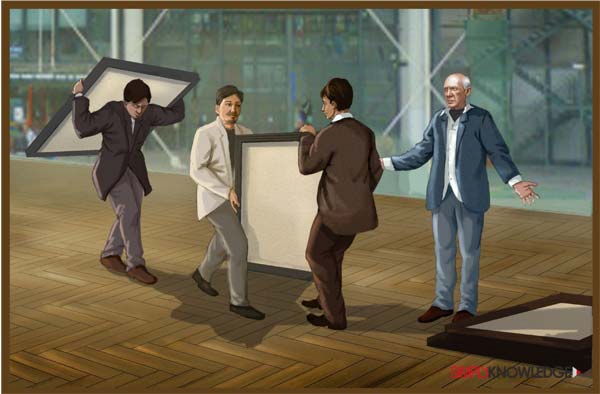
In 1937, an inhuman incident shocked the whole world, when a small fleet of the Nazi Air force raided the rural city of Guernica, Spain, killing thousands of civilians. During the airstrike, more than 5000 bombs were dropped on the defenseless city; the attack was in support of General Franco. The outcome of the bombing was horrendous. 1645 people died and more than 1000 were seriously wounded. The city was flattened to the ground level literally and this attack was a message to Spain and the whole world, that the Nazis were capable of anything. The images of Guernica aftermath printed in newspapers worldwide, sent chills down Picasso’s spine and he was shocked and angered at the same time. To commemorate the victims of Guernica, Picasso painted a huge mural which was 11ft high and 25ft wide. The making of this masterpiece was captured and well documented by Doora in form of photographs. Picasso’s ‘Guernica’ painting was cherished in Art Conclave held in Paris and the painting became an icon of peace, making Picasso an international celebrity. Many were impressed with Guernica but some of the critics acclaimed, “Painting is nothing but a private brain storm.”
The bloody civilian war ended in 1939 and Franco became the Leader of Spain. Picasso vowed that he would never return to his birthplace, until the fascist government stepped down.
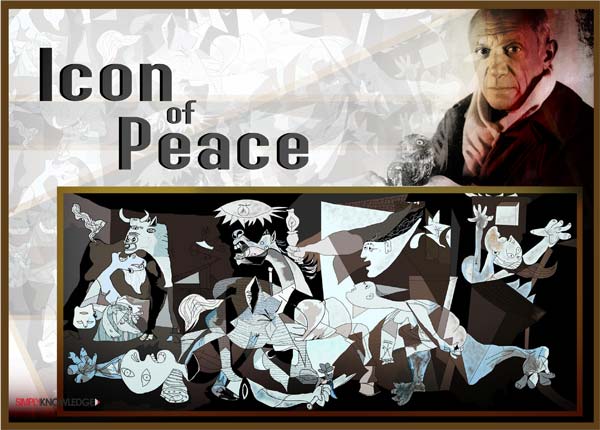
After Guernica, Picasso’s professional life was soaring high, but his personal life was falling apart. He was constantly confronted by his two mistresses as they did not want to share him anymore. Things worsened when Doora and Marie started living in the same house. Irrespective of the fights, Picasso treated both his mistresses equally; he spent nights with Doora and afternoons with Marie. Picasso even painted both his lovers in the same position, pose and place on alternate days. However, despite his efforts nothing remained hunky-dory and the arguments among the three became more severe. One day, Marie carrying her child, confronted Doora “he (Picasso) loves me more and is the father of my child”. The pain, anguish of both women was depicted by Picasso in his paintings and his pictures now looked more sad, angry and disturbed. The famous painting ‘Weeping Women’ was inspired by Dora’s sadness and pain and Picasso later confessed “it was worse part of my life.”

The imperial march
The following year was even worse for Picasso when Nazi Germany invaded Paris in 1940. The City of Lights was turned into a dark hostile prison. Picasso holed himself in his house, whereas his lovers and children were sent away somewhere safe in the country. During the Nazi invasion, Picasso contacted no one, not even Olga or his son Paulo. During the turmoil, the artist had an opportunity to leave the country and settle in Mexico or New York but he chose to remain in the city, not because of courage but because of sheer apathy. Art was Picasso’s life, his paintings were like his children and he wanted to save his work. The brutality of World War II took away Picasso’s desire to paint and now, an afraid, alone and sad Picasso stopped painting completely. He tried his best to shy away any Nazi attention and hardly went out. He was not a coward but was consumed with art and endeavoured to create one. During the dark period, Picasso wrote more than 300 poems, dedicated to kids, love and freedom. Picasso also worked on bronze sculptures. However, the metal was very rare in those days as the Nazi regime banned usage of bronze for commercial purposes and it was strictly limited for military usage. Nazis, in order to meet their bronze needs, ordered their men to melt down all the bronze statues erected in and around Paris. Picasso however was quite stubborn and to satisfy his hunger for art, he made arrangements to smuggle bronze secretly. This was treason and if he was caught, he would have received a severe punishment. Unafraid of the outcome, the machismo artist kept on risking his life for the sake of art.
To be really great, you don't only need passion and hard work, you also need to add an equal proportion of insanity. Decades later, Picasso was mentioned in one of the iconic Apple’s ‘Think Different’ ad campaign; Picasso was different and always created something different. Breaking, bending and creating rules!
The air of fascism made it difficult for the daring artist to breathe and he could not showcase his work to anyone. One morning, a Nazi Colonel and his foot soldiers barged into Picasso’s house and ransacked his studio in search of Jews. A postcard of Guernica painting was kept on the table, lifting one, the colonel asked “You did this?” Picasso promptly replied “No you did!”
Now here was a guy in his 50’s, with a small stature, sass mouthing to a Nazi Colonel, what would you call it? Stupidity? Courage? Naivety? No! It was the spirit of Truth. Picasso was not only courageous and truthful in his art but also in his deeds. He was not afraid of Nazi concentration camp or gas chamber. In his truly rustic demeanour, he reminded the colonel of their heinous crimes against the humanity. Respecting Picasso’s views, Nazi Colonel ordered his men to leave and not bother the artist again.
During the turmoil of World War II, Picasso met a bright, young and aspiring artist Francoise Gilot. She was an attractive and intelligent blonde who was passionate about art. Picasso often invited the 21 year old Gilot to his studio who posed for her idol on many occasions. One day while painting, Picasso asked Gilot to take off her clothes, so that he could see if her body could correspond with his mental image. Besotted with the artist, the pretty bombshell happily obliged.
By the year 1945, Hitler was dead; the brutal war had ended and Paris was liberated once again. Picasso was now free; the City of Lights came back to its original glittering form, and the celebration was everywhere. Recent war had now humbled the flamboyant artist; Picasso realized that life was very short and he dedicated himself to his art.
Picasso’s relation with Dora ended on a very sour note. She had a nervous breakdown and was admitted to a mental asylum. She later recovered but the scars left on her heart were never healed. She once said, “He (Picasso) used me until nothing was left of me...nothing but hundreds portraits of me he painted.”
On the other hand, Marie was confident that Picasso will marry her some day. Unfortunately, that day never came and Marie was also left heartbroken. Picasso’s treatment towards women was always an enigma, one moment he would glorify them and the next moment he would simply disdain them.

The Comrade
After the end of the Second World War, Picasso joined the communist party. He was never political, but after ‘Guernica’, politics could not stay away from him. He strongly believed that Stalin’s Communist Ideology ended the war. Picasso drew many criticisms with that remark, but he never cared about the critics. Picasso was against war and fascism, hence he chose Communism. On the other hand, communists were more than happy to have an influential artist among them. Picasso actively participated in all the communist conclaves held in Europe post World War II. He even boarded an airplane for the very first time, during his visit to England for gathering support for the communist party. Picasso drew a picture of the Dove which represented peace and thus was incorporated by the communist party as their official logo and symbol of peace. In his mid 60’s, Picasso was the richest and renowned communist party member ever. Picasso’s friend once asked him about his experience of being part of the Communist Party and his answer was “I have joined a family, and like all families it’s full of shit!”
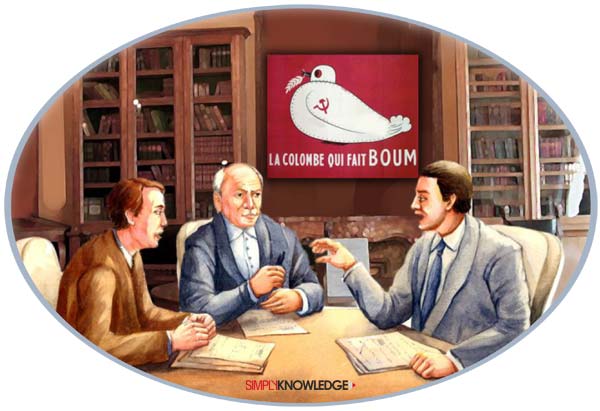
Back in United States, FBI founder J Edgar’s team closely kept an eye on Picasso and his communist activities. An anti communist by nature, Edgar believed, that in future when Picasso would apply for US visa, he should be denied it at all costs. Edgar feared that Picasso’s presence and communist views in the United States would disrupt their war against communism. For many years Picasso’s telegrams were intercepted by the FBI in order to dig out dirt but nothing substantial ever came out.
All this while, unaware of the foreign conspiracy, Picasso engaged himself in art and political endeavours. He turned his attention to his old friend and rival Matisse, who was battling for health. In spite of severe condition he still held the same artistic panache. One day Picasso paid a visit to the ailing painter along with his new love Gilot. Seeing Picasso’s beautiful girlfriend, Matisse offered to paint her “I will paint your hair green and your body thin”. The remark kicked in jealousy in Picasso’s heart and soon after returning home, Picasso painted his version of Matisse concept. Although in his 60’s, yet, Picasso was still competitive and never backed away from any challenge thrown at him. With Gilot now by his side, Picasso was rejuvenated and he started capturing nature, animals and his girlfriend on canvas. He used cheerful, happy colours and felt young again. In the year 1947, Gilot gave birth to a baby boy and the couple named him Claude. The toddler ignited Picasso’s spirits and he would often spend hours playing with him and swimming in the sea. Picasso’s life was financially secure, the money was abundant, his work was still in demand and many of the old unsold paintings now carried huge price tags. Picasso always made sure that he remained close to all his children, but somehow he remained fuzzy about his first legitimate son Paulo. He once told his friend “Isn’t it terrible for a man like me to have a son like that”. The reason for his animosity towards his son was however, unknown.
Throughout his life, Picasso maintained a cordial relationship with all his mistresses, but his true love remained only for Gilot. In the year 1948, the couple moved to Velaris, a small town famous for pottery from the Roman era. Picasso showed keen interest in ceramics and went on to create artworks in pottery and erect structures made from plaster. In the midst of nature, Picasso purchased a home in an isolated place which was not easily accessible. In 1949, Gilot gave birth to a baby girl whom they named Paloma. After the birth of two kids, Picasso found Gilot least attractive. He still loved her, but she no longer fed his artistic inspiration. Throughout his life, Picasso treated women as queen but later on disdained them like a pauper. Picasso once told his friend “there are two kinds of women...goddesses and door mats.”
Gilot was an ambitious woman and as soon as she discovered that Picasso was having an affair with Geneviere Laporte, a younger woman than herself, she left home along with her kids. For the very first time in his life, Picasso was heartbroken and sad. He could not believe that Gilot had left him. Absorbed with grief, loneliness and anger Picasso often rendezvoused with younger women in order to relieve his physical and artistic desires.
In 1953, Joseph Stalin passed away, and to commemorate his hero, Picasso drew a poster of Stalin as a martyr, earning him respect from the fellow comrades but largely criticism, from the democratic western world. People wondered, why an artist who gave such a powerful and peaceful contribution to world peace, praised an executioner and a harsh communist leader like Stalin. Picasso, unfazed by the critics, kept on promoting the communist ideology. He always spoke in favour of communism, turning a blind eye to the cruelty which the people suffered behind the iron curtain of the Soviet Union. Picasso’s work on ‘Guernica’ and his ethics were questioned, but he was a true comrade, ready to sacrifice his art for communism.

Minotaurs Final Battle
After Gilot left him, Picasso concentrated on ceramics and pottery. He unleashed his creative genius by moulding and designing pots and vases. Once while visiting the ceramic workshop, Picasso met Jacqueline Roque. She was the wife of a French colonial officer stationed in Africa. Unhappy with her marriage, she left her husband and shifted to Velaris in search of harmony. She took up a job at the ceramic factory. Jacqueline was a beautiful, mature, caring woman. No wonder Picasso was attracted to her. She too, spent quite a lot of time with the artist. Picasso had found his new muse; he dedicated many paintings and sculptures to Jacqueline. The following year Matisse passed away. Picasso always feared ageing and after Matisse’s demise he now feared his own death. Picasso started working ferociously, creating artwork one after another in his remaining days.
In 1955, Olga also passed away, once again reminding Picasso the inevitability of death. Olga had never sought her relation with Picasso again since their separation. Now free from bonds, Picasso married Jacqueline at their private estate in 1961. Jacqueline was an ideal partner for Picasso; she loved him unconditionally and took proper care of him. During the wedding function, Picasso raised a toast “Drink to me, Drink to my health, you know I can't drink anymore.” The couple lived a very private life. Friends were now turned away and even the children could never meet their father in his later years. Picasso now old and bitter, drained of creativity, started cannibalizing work of prominent artists. He painted many brutal versions of old classic paintings. Running short of inspiration and ideas for new paintings, Picasso remained angry all day, and it continued for many months to come.
The years flew by in isolation, when his past came back knocking his door. In 1964, Francoise Gilot published a book titled ‘Life with Picasso’ which was a tell-all book. Picasso was enraged on learning about it. He expressed his anguish and persuaded the publishers to stop the book from hitting the market. In spite of exercising his political pressure, the book was released and it became a best seller.
The following year, disgruntled over Gilot’s betrayal, Picasso slowed down. He was now battling with his illness as he had developed ulcers and prostates. Very secretly, Picasso was taken to a hospital for the treatment. Soon after his recovery, Picasso started painting again. His new battle was now against time. After his series of illness, Picasso lost his ability to make love and was devastated by his impotency. However, knowing his appetite for sex, the urge always remained within him and his new paintings now only depicted sex, lust, self pleasure and anguish.
In 1973, Pablo Picasso died at the age of 91. The circumstances of his death were never revealed and he left behind a huge legacy of modern art. During his funeral, Jacqueline turned away all the reporters, family members and some of the close friends of Picasso. The family could only see the funeral procession from a nearby hill. Picasso was buried in his private estate, under a sculpture of a woman holding a vase, which was built by him.
This prophecy of Picasso came true when two years later, in 1975, his son Paulo passed away due to alcohol abuse. Then in 1977, Marie Therese committed suicide by hanging herself and in 1986, Jacqueline committed suicide by shooting herself.
At the time of Picasso’s death, many of the paintings were in his possession. He had kept them off art market as he did not want to sell all his work. Some of the paintings were for his personal amusement. In addition to his own work, Picasso also had a considerable collection of paintings created by other famous artists. Picasso had not made any will and his death duties to the French state were paid in the form of his works and others from his art collection. In 2003, relatives of Picasso inaugurated a museum dedicated to him in his birthplace, Malaga, Spain, the ‘Museo Picasso Málaga’.
The Museu Picasso in Barcelona features many of his early works created while he was living in Spain, including many rarely seen paintings which reveal his firm grounding in classical techniques. The museum also holds many precise and detailed figure studies done in his youth under his father’s tutelage, as well as the extensive collection of Jaime Sabartés, his close friend and personal secretary.
If we turn a blind eye to Picasso’s vices, we will find an enormous treasure of talent, determination and creativity. No other painter since Picasso’s departure has been so influential to filmmakers, architects, graphic designers and advertising gurus. You can love his art or simply hate it but you cannot ignore it.
Next Biography





